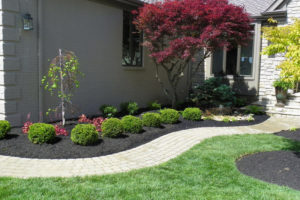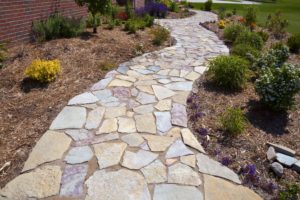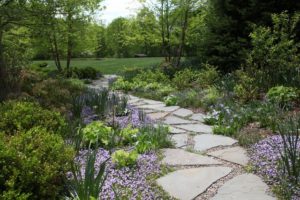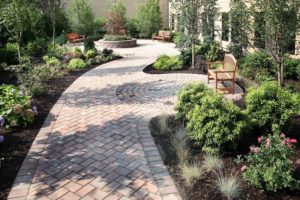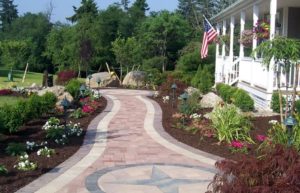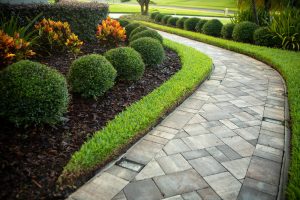Creating an inviting outdoor walkway or path not only enhances the aesthetics of your landscape but also provides practical access through your garden. Whether you’re looking to connect your home to your garden, create a charming path through a flower bed, or establish a route to a secluded seating area, the design and materials you choose will play a significant role in the overall effectiveness of the pathway. This guide will explore various aspects of walkway construction, including planning, materials, design, and maintenance, ensuring your outdoor path is both functional and visually appealing.
Make Paths Fun and Beautiful
Paths and walkways should be inviting so it’s a good idea to add fragrant plants (roses, lavender, etc.) near your paths. A path can meander a bit to make the walk more of a scenic stroll by plants, shrubs, and small trees. Use these images of walkways to gather some inspiration…
Understanding the Purpose of Your Pathway
Before embarking on the construction of your walkway, it’s essential to consider its primary purpose. Understanding how you intend to use the path will guide your decisions throughout the planning and building process.
Primary Paths: The Main Arteries
Primary paths serve as the main thoroughfares in your outdoor space. They connect crucial areas such as your front door to the street or driveway, facilitating high foot traffic. When designing these paths, focus on durability and ease of maintenance, as they will bear the brunt of everyday use.
Secondary Paths: Adding Depth to Your Landscape
Secondary paths branch off from primary routes, leading to areas like vegetable gardens, benches, or hidden corners of your yard. These paths can be narrower and more whimsical, enhancing the depth and character of your garden while inviting exploration.
Tertiary Paths: Casual Exploration
Tertiary paths are the least formal and least traveled, often leading to secluded spots in your garden. These paths can be simple and understated, offering a chance for quiet reflection and exploration of your outdoor space.
Planning Your Path’s Route
The route of your pathway is crucial for both functionality and aesthetics. Proper planning will ensure that your path serves its intended purpose while enhancing the beauty of your landscape.
Straight vs. Curved Paths
Straight paths are often more formal and work well near the house, extending the architecture outward. However, adding curves can create a more relaxed and inviting atmosphere. Curved paths can also navigate around obstacles like trees and flower beds, providing a more natural flow to your landscape.
Creating Visual Interest
A well-planned path can draw attention and guide visitors through your garden. Consider how the path will appear from various vantage points. A winding path that disappears around a corner can create intrigue and encourage exploration, while a straight path can make a space feel longer and more expansive.
Practical Considerations
When plotting your path, consider practical factors such as drainage, sunlight exposure, and existing landscape features. Ensure the path does not obstruct natural water flow and utilize shady areas for comfortable walking during hot summer days.
Determining the Ideal Path Width
The width of your walkway is essential for its usability and aesthetic appeal. A well-proportioned path will enhance the overall design of your outdoor space.
Width Recommendations for Different Path Types
-
- Primary Paths: Should be at least 48 inches wide to accommodate two people walking side by side comfortably.
- Secondary Paths: Typically range from 30 to 36 inches wide, allowing for easy access without taking up too much space.
- Tertiary Paths: Can be narrower, often around 24 inches, to create an intimate and cozy feel.
Accommodating Equipment
When designing your path, consider the types of equipment that may need to traverse it, such as lawn mowers or garden carts. Ensure the path is wide enough to accommodate these tools without difficulty.
Selecting the Right Materials
The materials you choose for your walkway will significantly impact its appearance, durability, and maintenance requirements. Selecting the right surface is crucial for creating a path that complements your home and landscape.
Soft Surface Options
Soft surfaces, such as mulch, pine needles, and grass, provide a natural and informal appearance. While they are often less expensive, they may require more frequent maintenance and replenishment over time.
Hard Surface Options
Hard surfaces, including brick, concrete pavers, and natural stone, offer greater durability and a more polished look. These materials typically require less upkeep but can be more costly to install.
Factors to Consider When Choosing Materials
When selecting materials, consider how they complement your home’s architectural style. A cohesive look can be achieved by matching the walkway materials with the materials used in your home. Alternatively, contrasting materials can add visual interest, provided they are balanced and harmonious.
Popular Pathway Materials
Choosing the right material for your walkway is crucial for both aesthetic and functional purposes. Here are some popular options to consider:
Gravel and Crushed Stone
Gravel and crushed stone are affordable, easy to install, and available in various colors and sizes. They provide excellent drainage and a non-slip surface, but they require edging to keep the stones in place and may need periodic raking for maintenance.
Brick
Brick walkways offer a timeless aesthetic and come in various patterns. They are relatively inexpensive, require minimal maintenance, and can withstand harsh weather conditions, making them a popular choice for many homeowners.
Natural Stone
Natural stone paths exude elegance and durability. While they may be more expensive and challenging to install, they provide a unique and stunning appearance. Stones can be set in sand or mortared in concrete, depending on your preference.
Concrete Pavers
Concrete pavers are versatile and often more affordable than natural stone. Available in numerous shapes, sizes, and colors, they allow for creative designs and patterns.
Mulch
Mulch paths, including bark and pine needles, work well in informal areas. They provide a soft, natural surface but may require regular replenishment as they decompose over time.
Grass
A grass path can create a seamless and soft look in your garden. However, it requires regular maintenance, including mowing and watering, and may struggle in high-traffic areas.
Preparing the Base for Your Path
A solid foundation is vital for ensuring the longevity and stability of your walkway. The preparation of the base will determine how well your path holds up over time.
Establishing a Stable Base
Most walkways require a base of coarse crushed stone to remain level. The depth of this base will depend on your soil type and climate, typically ranging from 4 to 8 inches.
Ensuring Proper Drainage
To prevent water pooling, slope the path away from your home or other structures. A slight incline of 1/4 inch per foot of path width is recommended. For areas with heavy clay soils, consider installing a perforated PVC pipe within the gravel base for additional drainage support.
Installing Your Walkway
Once you have planned the route and prepared the base, it’s time to install your walkway. Follow these steps to ensure a successful installation.
Laying Out the Path
Begin by marking the path’s route using stakes and string or garden hoses. This will help you visualize the path and make adjustments as needed. If the path will see frequent traffic, ensure it is wide enough for comfortable passage.
Adding a Sand Layer
After establishing the base, lay down a 1- to 2-inch layer of sand over the crushed stone. This will serve as a leveling course, allowing you to adjust the stones or pavers for a perfect fit.
Placing the Stones or Pavers
Begin placing your chosen materials along the path, ensuring they fit together snugly. Leave small gaps if you plan to fill them with sand or gravel, or wider gaps if you intend to plant between the stones. Use a carpenter’s level to ensure each piece is stable and level.
Filling the Gaps
Once all materials are in place, fill any gaps with sand or gravel, spreading it evenly and using a broom to settle it into place. If planting, fill the gaps with potting soil mix, then add suitable ground cover plants.
Enhancing Your Pathway with Landscaping
To create a cohesive and inviting outdoor space, consider incorporating landscaping elements along your walkway. These additions can enhance the visual appeal of your path and tie it into the surrounding garden.
Edging with Plants
Integrating low-growing plants between pavers or stones softens the look of your walkway and adds life to the space. Choose plants that can tolerate foot traffic, such as creeping thyme or sedum, to create a lush and fragrant border.
Incorporating Lighting
Adding lighting along your path can enhance safety and create a warm ambiance during evening strolls. Consider installing solar lights, lanterns, or low-voltage lighting to illuminate your walkway and highlight key features in your garden.
Seasonal Decorations
Seasonal decorations can add a festive touch to your walkway. Consider using planters, seasonal flowers, or decorative elements that reflect the changing seasons, making your path a focal point throughout the year.
Maintenance Tips for Your Walkway
Regular maintenance is essential for keeping your walkway looking its best and ensuring its longevity. Here are some tips to help you take care of your path:
Routine Cleaning
Sweep your walkway regularly to remove debris and prevent weed growth. For hard surfaces, consider occasional power washing to maintain their appearance and remove stubborn stains.
Addressing Damage Promptly
If you notice any damage, such as cracked stones or shifting pavers, address it promptly to prevent further deterioration. This may involve resetting stones, patching cracks, or refilling gravel as needed.
Seasonal Maintenance
In winter, avoid using harsh de-icing chemicals that can damage your path. Instead, use sand or kitty litter for traction. In spring, check for frost-heave damage and make any necessary repairs to ensure your walkway remains safe and functional.
We Build Inviting Patios, Walkways, and Driveways
Patio / Walkway / Driveway installation services offer property owners a valuable opportunity to create inviting and functional outdoor living spaces. These services typically involve the design, material selection, and construction of patios tailored to the specific needs and preferences of the client. Professional installers can provide guidance on factors such as patio size, layout, and material options, taking into account the existing landscape, architectural style, and intended use of the space.
> Learn More
Building an outdoor walkway or path requires careful planning, material selection, and proper installation. Whether you opt for a rustic gravel path or an elegant stone walkway, your choice should enhance your home’s architecture and complement your garden’s style. By considering functionality, aesthetics, and maintenance, you can create a beautiful and practical path that invites exploration and enhances your outdoor living space. With the right approach, your walkway will serve as a delightful journey through your garden for years to come.
Contact Us (859-781-0677) for More Information!
—
 About Davis Landscaping
About Davis Landscaping
Davis Landscape Design & Installation has been providing landscaping services to customers in Northern Kentucky and Greater Cincinnati since 1965! We know that the landscape design process can be overwhelming, so we work with you tirelessly to better understand your vision. At Davis Landscape Design & Installation, we’re on your team and we know how to listen and deliver.

